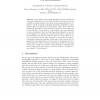Free Online Productivity Tools
i2Speak
i2Symbol
i2OCR
iTex2Img
iWeb2Print
iWeb2Shot
i2Type
iPdf2Split
iPdf2Merge
i2Bopomofo
i2Arabic
i2Style
i2Image
i2PDF
iLatex2Rtf
Sci2ools
GW
2003
Springer
2003
Springer
Hand Postures Recognition in Large - Display VR Environments
Large–display environments like Reality Center or Powerwall are recent equipments used in the Virtual Reality (VR) field. In contrast to HMDs or similar displays, they allow several unadorned users to visualize a virtual environment. Bringing interaction possibilities to those displays must not suppress the users’ liberty. Thus, devices based on trackers like DataGlove or wand should be forgotten as they oblige users to don such gear. On the contrary, video cameras seem very promising in those environments: their use could range from looking for a laser dot on the display to recovering each user’s full body posture. The goal we are considering is to film one’s hand in front of a large display in order to recover its posture, which will then be interpreted according to a predefined interaction technique. While most of such systems rely on appearance–based approaches, we have chosen to investigate how far a model–based one could be efficient. This paper presents the first...
| Added | 06 Jul 2010 |
| Updated | 06 Jul 2010 |
| Type | Conference |
| Year | 2003 |
| Where | GW |
| Authors | Jean-Baptiste de la Rivière, Pascal Guitton |
Comments (0)

